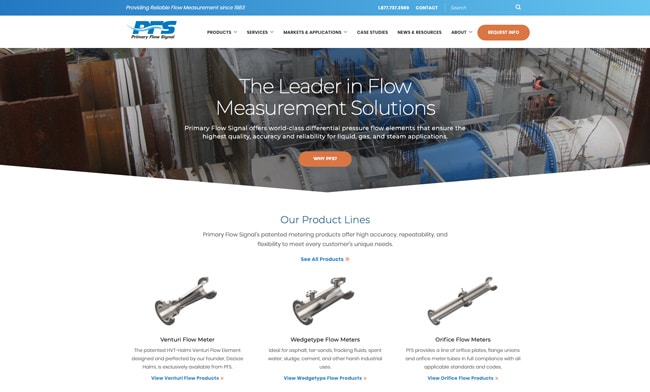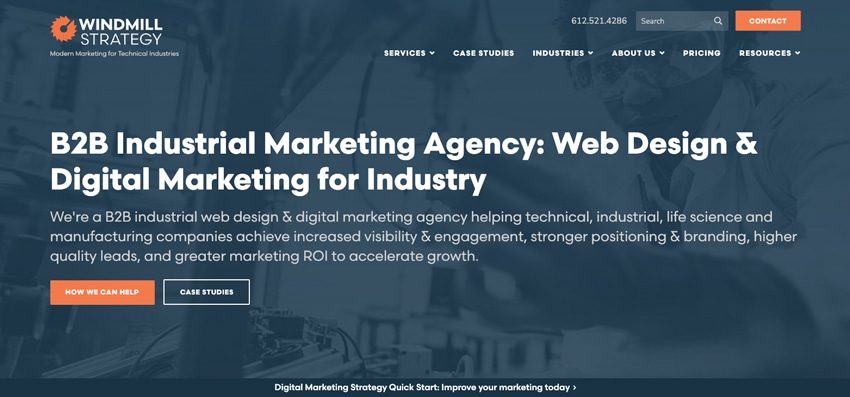How to Write Breakthrough B2B Positioning Statements that Separate You From Competitors

How to Write Breakthrough B2B Positioning Statements That Separate You From Competitors
Would you hire a job candidate based on their name alone?
Of course not.
You need answers to many questions before making any hiring decision.
That same rule applies to your company website. You need more information on your homepage than a logo and company name to quickly communicate what your firm does, who it serves, and why you’re better than competitors.
You have to be able to communicate it in less than five seconds.
That’s about how much time a prospect will spend on your homepage before they decide to look further.
The few hundred characters that communicate essential facts about your company on the homepage is called the brand positioning statement. For B2B technical companies — industrial, manufacturing, life science, and technology businesses — that are leveling up their marketing, the positioning statement is a strategic building block.
That’s because most B2B technical companies aren’t household names and haven’t spent millions of dollars for years to build a brand. These are the businesses that appear on Inc. magazine’s top 5,000, not the Fortune 500.
Inside your company, your teams may be crystal clear about what you do, who it’s for, and why you’re different. The key, however, is do your customers and prospects know exactly what you provide and to whom without thinking about it too long? The positioning statement communicates these critical facts.
If your positioning is confusing, inconsistent, outdated, or undefined, now’s the time to develop a differentiated positioning statement.
What is a Positioning Statement
A positioning statement is a core part of your marketing plan, but it goes much further than that. By distilling your business plan and elevator pitch into a few short sentences that concisely declare what you do, who you help, and how you do it, you provide direction to all marketing and new business initiatives.
However, instead of writing it like an internal-only mission or vision statement, write the message so your prospects will want to learn more about you. Again, make it concise and clear, and include it on your website’s homepage and every marketing touchpoint.
How many B2B websites have you visited that have a slider on the homepage that features new product launches, news items, and leadership announcements but no clear information about what the company does, who it’s for, and how they can help?
Or how about those websites with numerous hero images and corresponding generic platitudes like “Your Innovation Solutions Partner” or “A Leading Collaborative Solutions Provider?” These vague statements can apply to just about any company, and tell the visitor nothing about what the business offers, whether it’s suited to them, and if they should take the time to try to learn more.
Have you ever read something like this statement and thought to yourself, “huh?”
“We harness deep industry, process and technology expertise and unrivaled large-scale, complex change capabilities.”
– Accenture annual report; source: “Why Business People Speak Like Idiots: A Bullfighter’s Guide”
Not exactly a crystal clear message. Advertising great David Ogilvy advised us to:
“Write the way you talk. Naturally. Use short words, short sentences and short paragraphs.” Advice even more valuable in our digital age.
In the past, marketers could create intrigue through clever quips and headlines. Not any more. A modern B2B website homepage is not a place to be mysterious or witty, it’s a place to be precise. Prospects are on a hurried mission searching for information they need.
We find the key is to simplify your message so you’re clear and concise. Mark Twain offers this timeless guidance:
“Use plain, simple language, short words and brief sentences. That is the way to write English—it is the modern way and the best way. Stick to it; don’t let fluff and flowers and verbosity creep in.”
Most positioning statements share three critical pieces of information:
- Who you serve: It must be more specific than anyone and everyone. Write to your ICP (ideal customer profile).*
- What you do: This is the product/service category of (tangible deliverable) your client of working with you – what’s in it for them, and how are you helping them succeed?)
- What’s unique about working with you: What differentiates you or makes you better than the competition? Why should they choose you? Why does your work matter? Why should anyone care?
*Note: If you haven’t yet defined your ICP (Ideal Customer Profile) and have a good understanding of your key personas, this will be a more challenging exercise.
Read about defining your ICP and personas, and go through the exercises noted in that article first, then think through the positioning statement from the point of view of your ICP and primary personas.
Additionally, your positioning statement is easier to create if you’ve already done a great job of defining your mission, vision, core values and company direction in a document like the EOS VTO (Vision Traction Organizer).
Another great initial exercise is a Brand Sprint, which helps leaders to get on the same page about who you are, why you do what you do, and where you’re going. We’re big proponents of agile methodologies and a bias for action, but the foundational work to define these pieces is critical and can be done relatively quickly with focused effort.
These three topics may also be a lot to pack into one sentence, but the work to produce it will help you both in the long- and short-run as you improve communications with your prospects.
A common framework to begin your positioning statement is the formula:
“We do _______ for _______.”
Brainstorm around this formula but don’t worry about perfecting the language. Use it as a starting point.
Ponder these other key points as you work on your positioning statement
- Is the focus narrow enough for you to become a global leader in this space?
- Is it broad enough to build the business you want to develop?
- Are you excited about it?
- Does it spell out who you would call for new business opportunities and how you would introduce yourself?
- Can you say it out loud without stumbling?
- Is it short enough that your team can learn it, memorize it, repeat it?
- Will it signal to poor-fit prospects that you’re not for them?
- Will it motivate good-fit prospects to learn more?
The positioning statement may or may not be your SEO-optimized H1 on your website (think of this H1 as the CliffsNotes version). Ensure it’s also in your homepage’s hero area (the first and most prominent content area, right below the main navigation).
Here’s Windmill Strategy’s current positioning statement:
“We’re a B2B industrial web design & digital marketing agency helping technical, industrial, life science and manufacturing companies achieve increased visibility & engagement, stronger positioning & branding, higher quality leads, and greater marketing ROI to accelerate growth.”
The statement is paired with our larger, SEO-optimized H1:
“B2B Industrial Marketing Agency: Web Design & Digital Marketing for Industry”
Positioning Statements for Multiple Audiences, Personas & Vertical Industries
Your positioning statement should be broad enough to speak to all of your customers and is never-changing. A close cousin to the positioning statement, however, is the reassurance statement. When you pair your positioning statement with a reassurance statement, you can get more specific and speak directly to different industries, audiences, or customers for different divisions or products within your company. This statement can imply expertise or quality, further differentiation of discipline and market, and change from audience to audience.
B2B and industrial companies with several audiences, divisions, products or service lines can benefit from developing a content matrix. The matrix can be a simple spreadsheet or outline, a content matrix is used to identify the primary themes and messaging presented to key audiences (personas), their key issues, needs/problems, and how your company solves and communicates your value proposition.
Reassurance statement examples
These reassurance statements are secondary messaging that can accompany your positioning statement, getting more granular to address the specific needs of different verticals, personas and service lines:
Audience 1: Manufacturing and industrial
We help manufacturing and industrial companies engage technical buyers and senior leaders, while positioning you as a leading supplier. The result: you’ll stand apart from the competition, generate more quality leads, and close more business.
Audience 2: Technology, engineering and technical services
We help technology, engineering, technical consulting and other B2B companies engage technical influencers and C-level decision-makers while positioning you as a leader in your field. You’ll stand apart from the competition, generate more quality leads, and close more business.
Audience 3: Life sciences and medical
We help medical device, med-tech, pharmaceutical, medical and life science companies identify and engage sophisticated buyers with persuasive and effective marketing strategies that help position you as a leader in your segment. In the process, you’ll stand apart from your competitors, generate more leads and proposals and close more business.
Positioning Statement in Marketing
We like to create positioning statements you can really use; not a statement that’s only used inside your company. If you Google “positioning statement examples,” you’ll find articles like this one from HubSpot that lists numerous strategies to help you create positioning statements along with many examples. Many examples, however, are too long and thus unfit as the opening statement on your homepage.
Perhaps it’s our B2B and industrial bent, practicality, or the fact that we help people who already don’t have enough time in the day, but we like to minimize academic exercises and create things that can stand on their own in production.
In addition to your marketing plan and internal documents, your identical positioning statement should be used on the following marketing assets:
- Website homepage
- Website About page
- Back of product sell sheets
- The opening of sales capabilities presentations
- Employee LinkedIn profiles
- Display ads (sometimes shortened)
- Marketing emails (beginning or end)
- White papers (beginning or end)
- Landing pages
- Brochures
- Press releases
- Anywhere else a prospect might be learning about you for the first time
Your positioning statement also generates trust and helps attract the right people when used in your talent recruitment and onboarding materials. (A different type of marketing, yet also critically important.)
More B2B positioning statement examples
- We develop and manufacture high-performance elastomer and thermoplastic components and assemblies for the Medical Device, Transportation, and Food, Beverage & Water Industries.
- We offer world-class differential pressure flow elements that ensure the highest quality, accuracy and reliability for liquid, gas, and steam applications.
- We provide the full range of commercial construction services with the highest levels of craftsmanship and honor. We tailor our services to meet your specific needs, budget and timeline. We also work hard to earn – and keep – your trust by transparently and consistently delivering on our promises.
- We develop innovative, cost-effective medical devices that improve procedural performance and workflow while delivering advantageous outcomes for physicians, healthcare professionals and hospitals.
No, these statements won’t earn you top marks in your creative writing class. However, when marketing to a technical audience, clear, straightforward and concise wins the day.
Moreover, if you can work in some added interest or alliteration, that’s the icing on the cake. Yep, even though you need to be clear about writing your marketing content, it doesn’t have to be dry. There are plenty of other areas where you can use more attention-grabbing headlines and your unique brand voice.
Make Your Positioning Statement Stand Out
B2B marketing in the digital age poses unique challenges. You and your competitors are likely fighting for the attention of the same busy prospects. When your prospect lands on your homepage, you only have a few seconds to engage them with a clear, unmistakable positioning statement. Is it clear about what you do and for whom? If yes, they’ll stick around and explore your offerings further and learn more. If not, they won’t try to decode who you are and what you do. They’ll move on. Take the time now to create a positioning statement using the tips we’ve shared here. We think it’s a cornerstone of any B2B digital marketing plan.




